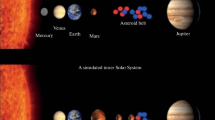Abstract
The effects of radiation from the young Sun and galactic cosmic rays on the physical conditions on the early Earth are significantly underestimated in studies of the problems related to the origin and evolution of the biosphere. This review considers the dynamics of solar and galactic processes over the 4.56 billion years of the existence of the Solar System. These factors substantially affected the development of adaptive technologies in ancient and modern living systems. The features of biosphere development are considered for the early Earth under the young Sun, which was fainter, but more flare active. The radiation spectrum of the young Sun is discussed together with the paradoxical mismatch between the solar radiation spectrum and the chlorophyll adsorption spectrum. Ways of solving the paradox are proposed. The role of solar radiation is important when studying models of the early biosphere of the Earth and hypothetical biospheres of giant planet satellites and exoplanets.






Similar content being viewed by others
REFERENCES
M. V. Ragulskaya, The Sun and the Biosphere: Billions of Years of Coexistence (Radiotekhnika, Moscow, 2019) [in Russian]. http://www.izmiran.ru/pub/izmiran/Ragulskaya-Sun-2019.pdf
E. G. Khramova, in Life and the Universe, Ed. by V. N. Obridko and M. V. Ragulskaya (VVM, St. Petersburg, 2017) [in Russian]. http://www.izmiran. ru/pub/izmiran/Life-n-Universe.pdf.
M. A. Nikitin, The Origin of Life: From Nebula to Cell (ANF, Moscow, 2016) [in Russian].
M. V. Ragulskaya, Tekhnol. Zhivykh Sistem 16 (5), 60 (2019).
V. A. Tverdislov and E. V. Malyshko, Usp. Fiz. Nauk 189 (4), 375 (2019).
A. Y. Mulkidjan and M. Y. Galperin, Biol. Direct 4, 27 (2009).
A. B. Struminsky, Doctoral Dissertation in Physics and Mathematocs (Moscow, 2011).
E. Rozanov, K. Georgieva, I. Mironova, et al., J. A-tmos. Solar-Terr. Phys. 149, 146 (2016).
O. V. Kochina, D. Z. Vibe, S. V. Kalensky, and A. I. Vasyunin, Astron. Zh. 90, 892 (2013).
Th. Henning and D. Semenov, Chem. Rev. 113, 9016 (2013).
K. I. Oberg, V. V. Guzman, K. Furuya, et al., Nature 520, 198 (2015).
D. Atri and A. Melot, Astroparticle Phys. 53, 186 (2014).
K. Wyman and S. Redfield, Astrophys. J. 773, A96 (2013).
Q. Pognan, C. Garraffo, O. Cohen, et al., Astrophys. J. 856, 1 (2018).
N. J. Shaviv, New Astronomy 8, 39 (2003).
H. Svensmark, Monthly Not. Roy. Astron. Soc. 423 (2), 1234 (2012).
V. S. Murzin, Introduction to the Physics of Cosmic Rays (Moscow State Univ., Moscow, 1988) [in Russian].
N. K. Belisheva, H. Lammer, at al., Astrophys. Space Sci. Trans. 8, 7 (2012). https://doi.org/10.5194/astra-8-7-2012
E. Gromozova, S. Voychuk, P. Grigoriev, et al., Sun Geosph. 7 (2), 117 (2012).
M. V. Ragulskaya, E. A. Rudenchik, S. M. Chibisov, and E. N. Gromozova, Bull. Exp. Biol. Med. 159 (2), 269 (2015). https://doi.org/10.1007/s10517-015-2939-0
M. Gudel, Living Rev. Solar Phys. 4, Article No. 3 (2007). https://doi.org/10.12942/lrsp-2007-3
V. N. Obridko and Yu. A. Nagovitsyn, Solar Activity: Cylicity and Methods of Prediction (VVM, St. Petersburg, 2017) [in Russian].
V. V. Pipin, Monthly Not. Roy. Astron. Soc. 466 (3), 3007 (2017).
M. V. Ragulskaya, Zemlya i Vselennaya, No. 3, 91 (2017).
E. Gaucher, S. Govindarajan, and O. Ganesh, Nature 451 (7179), 704 (2008).
C. Goldblatt and K. Zahnle, Nature 474, E1 (2011). https://doi.org/10.1038/nature09961
V. Obridko, M. Ragulskaya, and E. Khramova, J. Atmos. Solar-Terr. Phys. 197 (2020).
T. Abd-Deydan, S. V. Patsaeva, V. V. Fadeev, and V. I. Yuzhakov, Vestn. Mosk. Univ., Ser.: Fiz., Astron. 35 (2), 51 (1994).
T. S. Idrisov, M. A. Kurbanov, and U. A. Kulieva, Khim-. Bezopasn. 2 (2), 106 (2018).
E. Khramova, J. Atmos. Solar-Terr. Phys. 197 (2020).
Yu. I. Gurfinkel, Ishemic Heart Disease and Solar Activity (Elf-3, Moscow, 2004) [in Russian].
V. Cheptsov, E. Vorobyova, A. Belov, et al., Geosciences, No. 8, 298 (2018).
M. Simakov, in Origins: Genesis, Evolution and Diversity of Life, Ed. by J. Seckbach (Kluwer, 2004), pp. 645–665.
A. M. Sadovski, A. B. Struminsky, and A. V. Belov, Astron. Lett. 44 (5), 324 (2018).
F. Westall, F. Foucher, N. Bost, et al., Astrobiology 15, 998 (2015).
V. V. Vishnevsky, M. V. Ragulskaya, and S. N. Samso-nov, Tekhnol. Zhivykh Sistem, No. 4, 61 (2007).
M. V. Ragulskaya and V. V. Pipin, Dinam. Slozhnykh Sistem 1 (1), 17 (2010).
Biotropic Effect of Space Weather (VVM, St. Petersburg, 2010) [in Russian].
V. Obridko, M. Ragulskaya, E. Rudenchik, et al., Technol. Live Syst. 11 (3), 12 (2014).
S. M. Chibisov, G. S. Katinas, and M. V. Ragulskaya, Biorhythms and Cosmos: Monitoring Cosmobiospheric Connections (Moscow, 2013) [in Russian].
M. V. Ragulskaya, V. N. Obridko, and E. G. Khramova, in Proc. 4th Ruussian Congress of Biophysicists (Sochi, 2019), pp. 367–368 [in Russian].
Funding
This work was supported by the Program 17 The Evolution of the Organic World and Planetary Processes of the Presidium of the Russian Academy of Sciences and the Russian Foundation for Basic Research (project no. 18-52-06002-Az_a).
Author information
Authors and Affiliations
Corresponding authors
Ethics declarations
Conflict of interests. The authors declare that they have no conflict of interest.
This work does not contain any studies involving animals or human subjects performed by any of the authors.
Additional information
Translated by T. Tkacheva
Abbreviations: SCR, solar cosmic ray; GCR, galactic cosmic ray; ECG, electrocardiogram.
Rights and permissions
About this article
Cite this article
Ragulskaya, M.V., Obridko, V.N. & Khramova, E.G. Galactic Factors, the Young Sun, the Earth, and the Biophysics of Living Systems. BIOPHYSICS 65, 686–697 (2020). https://doi.org/10.1134/S000635092004017X
Received:
Revised:
Accepted:
Published:
Issue Date:
DOI: https://doi.org/10.1134/S000635092004017X




